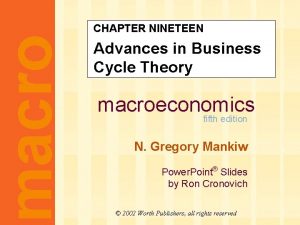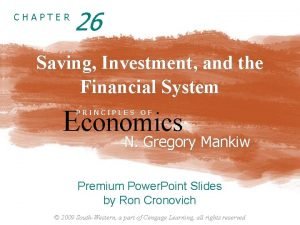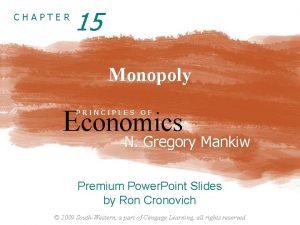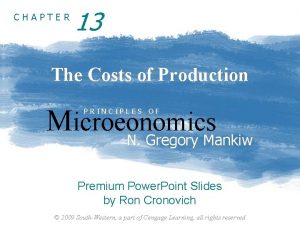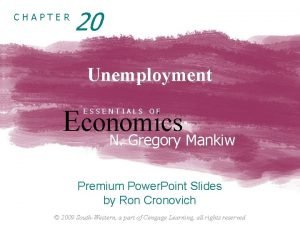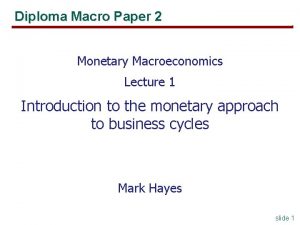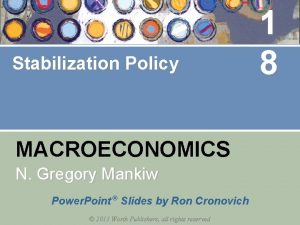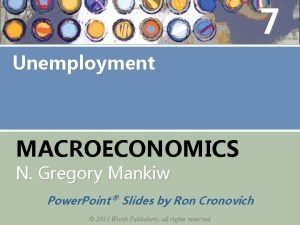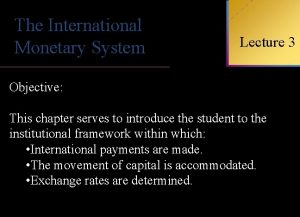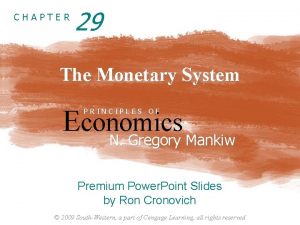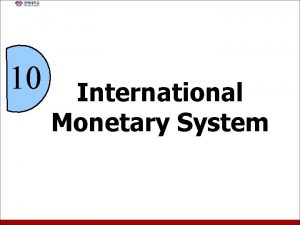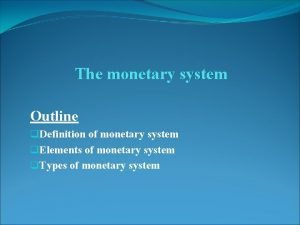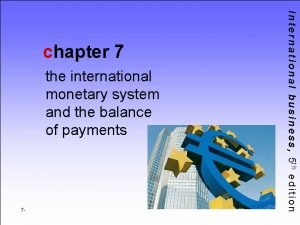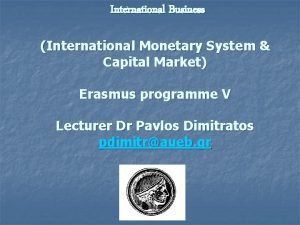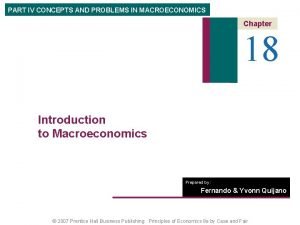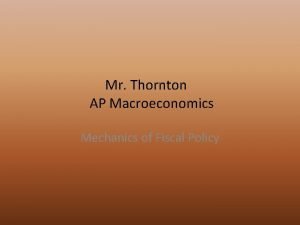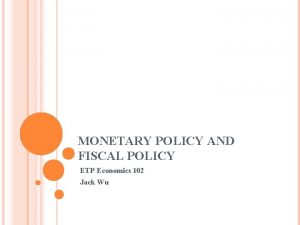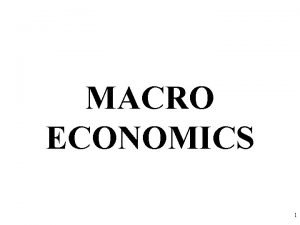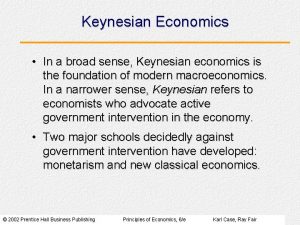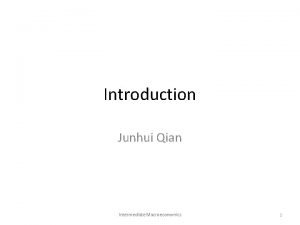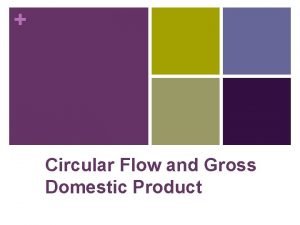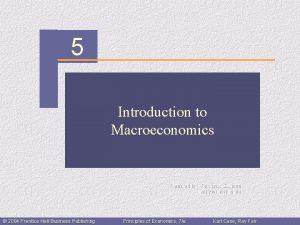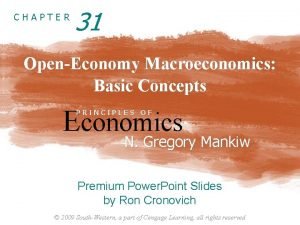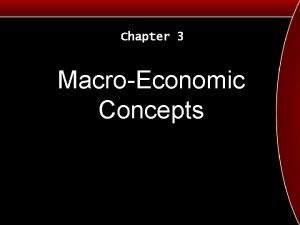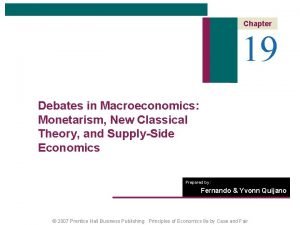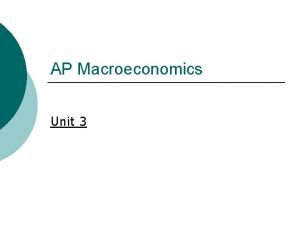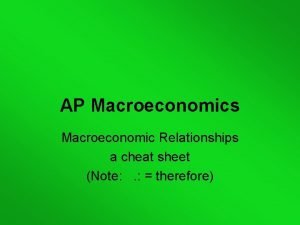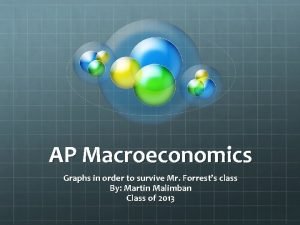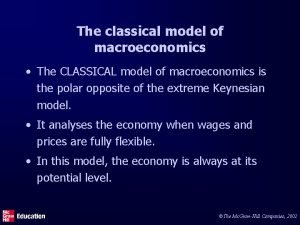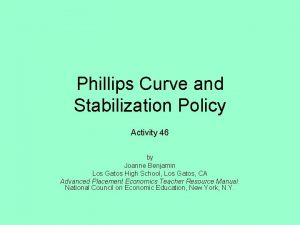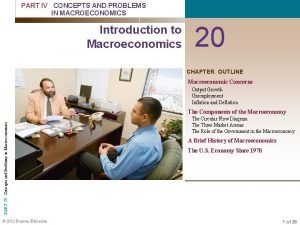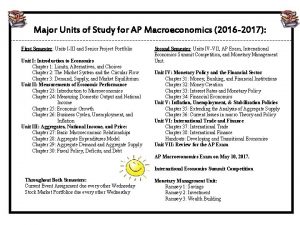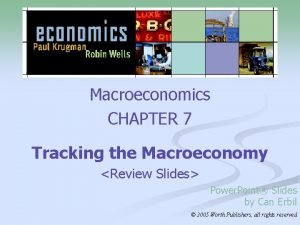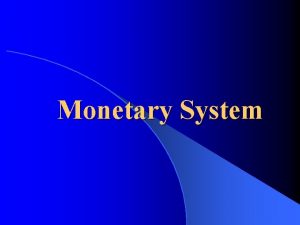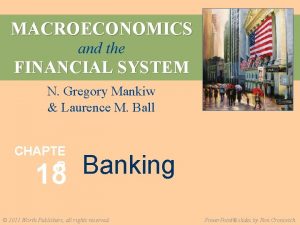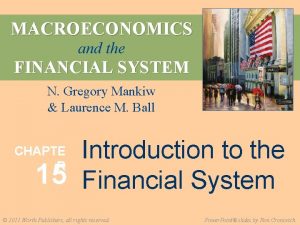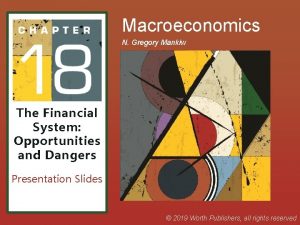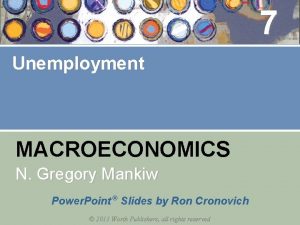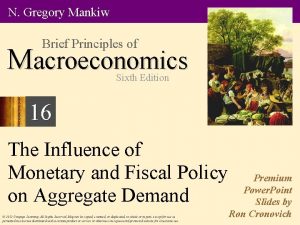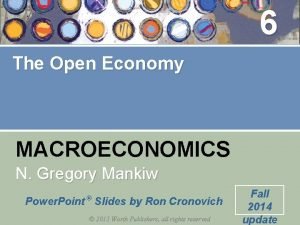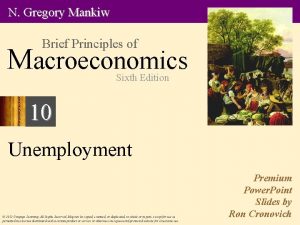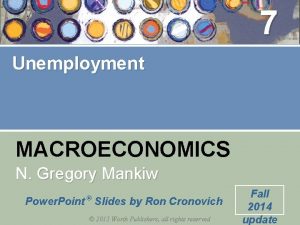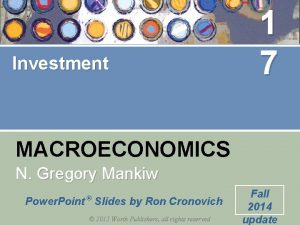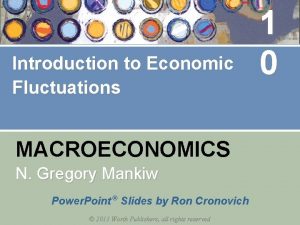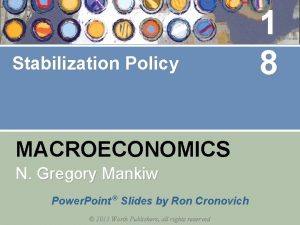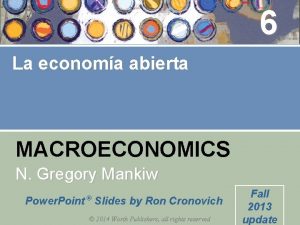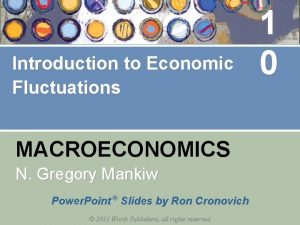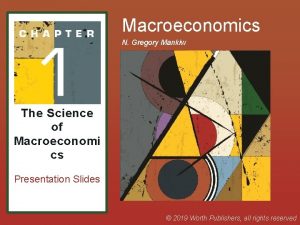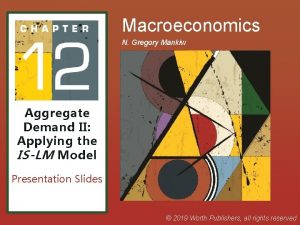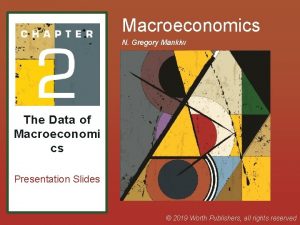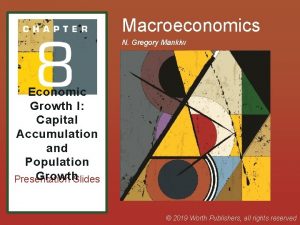Macroeconomics N Gregory Mankiw The Monetary System What











































- Slides: 43

Macroeconomics N. Gregory Mankiw The Monetary System: What it Is and How It Works Presentation Slides © 2019 Worth Publishers, all rights reserved

IN THIS CHAPTER, YOU WILL LEARN: The definition, functions, and types of money How banks “create” money What a central bank is and how it controls the money supply CHAPTER 4 3 The 1 National Science Monetary Income of System Macroeconomics

Money: Definition Money is the stock of assets that can be readily used to make transactions.

Money: Functions • Medium of exchange we use it to buy stuff • Store of value transfers purchasing power from the present to the future • Unit of account the common unit by which everyone measures prices and values

Money: Types 1. Fiat money • has no intrinsic value • example: the paper currency we use 2. Commodity money • has intrinsic value • examples: gold coins, cigarettes in POW camps

NOW YOU TRY Discussion question Which of these are money? a. Currency b. Checks c. Deposits in checking accounts (“demand deposits”) d. Credit cards e. Certificates of deposit (“time deposits”)

Money: Examples, part 1 • Deposits in checking accounts (“demand deposits”) • Yes, the funds in a checking account serve three purposes • Checks • The check itself is not money, but the funds in the checking account are money • Currency • Yes; U. S. dollar bills, Mexican pesos, and other currencies are all money

Money: Examples, part 2 • Certificates of deposit (“time deposits”), or CDs • Depends on the length of time; they are a store of value and are measured in money units (dollars, for example) but are not easily spent (medium of exchange) • As you’ll see in a few slides, there are multiple measures of the money supply • Credit cards • No, they are a means of deferred payment • For credit card purchases, you agree to pay back your credit card company in the future

Two definitions • The money supply is the quantity of money available in the economy. • Monetary policy is control over the money supply.

The central bank and monetary control • Monetary policy is conducted by a country’s central bank. • The U. S. central bank is called the Federal Reserve (“the Fed”). • To control the money supply, the Fed uses open-market operations, the purchase and sale of government bonds.

Money supply measures, July 2017 Symbol Assets Included Amount in July 2017 (billions of dollars) C Currency $ 1, 486 M 1 Currency plus demand deposits, traveler’s checks, and other checkable deposits 3, 528 M 2 M 1 plus retail money market mutual fund balances, saving deposits (including money market deposit accounts), and small time deposits 13, 602

Banks’ role in the monetary system, part 1 The money supply equals currency plus demand (checking account) deposits M=C+D Since the money supply includes demand deposits, the banking system plays an important role.

A few preliminaries • Reserves (R ): the portion of deposits that banks have not lent. • A bank’s liabilities include deposits; assets include reserves and outstanding loans. • 100 -percent-reserve banking: a system in which banks hold all deposits as reserves. • Fractional-reserve banking: a system in which banks hold a fraction of their deposits as reserves.

Banks’ role in the monetary system, part 2 • To understand the role of banks, we will consider three scenarios: 1. No banks 2. 100 -percent-reserve banking (banks hold all deposits as reserves) 3. Fractional-reserve banking (banks hold a fraction of deposits as reserves, use the rest to make loans) • In each scenario, we assume C = $1, 000.

Scenario 1: No banks With no banks, D = 0 and M = C = $1, 000.

Scenario 2: 100 -percent-reserve banking § Initially C = $1000, D = $0, M = $1, 000 § Now suppose households deposit the $1, 000 at “Firstbank. FIRSTBANK’S balance sheet Assets Liabilities Reserves $1, 000 Deposits $1, 000 After the deposit: C = $0, D = $1, 000, M = $1, 000 LESSON: 100%-reserve banking has no impact on size of money supply.

Scenario 3: Fractional-reserve banking (1 of 4) • Suppose banks hold 20% of deposits in reserve, making • loans with the rest. Firstbank will make $800 in loans. FIRSTBANK’S balance sheet Assets Reserves $200 Loans $800 Liabilities Deposits $1, 000 The money supply now equals $1, 800: • Depositor has $1, 000 in demand deposits. • Borrower holds $800 in currency.

Scenario 3: Fractional-reserve banking (2 of 4) • Suppose banks hold 20% of deposits in reserve, making • loans with the rest. Firstbank will make $800 in loans. The money supply FIRSTBANK’S balance sheet now equals $1, 800: • Depositor has Assets Liabilities $1, 000 in Reserves $200 Deposits $1, 000 demand Loans $800 deposits. • Borrower holds $800 in LESSON: In a fractional-reserve currency. banking system, banks create money.

Scenario 3: Fractional-reserve banking (3 of 4) • Suppose the borrower deposits the $800 in Secondbank. • Initially, Secondbank’s balance sheet is: FIRSTBANK’S balance sheet Assets Reserves $160 Loans $640 Liabilities Deposits $800 Secondbank will loan 80% of this deposit.

Scenario 3: Fractional-reserve banking (4 of 4) • If this $640 is eventually deposited in Thirdbank, • Then Thirdbank will keep 20% of it in reserve and loan out the rest: FIRSTBANK’S balance sheet Assets Reserves $128 Loans $512 Liabilities Deposits $640

Finding the total amount of money Original deposit = $1000 + Firstbank lending = $ 800 + Secondbank lending = $ 640 + Thirdbank lending = $ 512 + other lending… Total money supply = (1/rr ) × $1, 000 where rr = ratio of reserves to deposits In our example, rr = 0. 2, so M = $5, 000

Money creation in the banking system A fractional-reserve banking system creates money, but it doesn’t create wealth. Bank loans give borrowers some new money and an equal amount of new debt.

Bank capital, leverage, and capital requirements, part 1 • Bank capital: the resources a bank’s owners have put into the bank • A more realistic balance sheet: Assets Reserves Loans Securities Assets $200 Liabilities and owners’ equity Deposits 500 Debt 300 Capital (owners’ equity) Liabilities and owners’ equity $750 200 50

Bank capital, leverage, and capital requirements, part 2 Leverage: the use of borrowed money to supplement existing funds for purposes of investment Leverage ratio = assets/capital = $(200 + 500 + 300)/$50 = 20 Assets Reserves Loans Securities Assets $200 Liabilities and owners’ equity Deposits 500 Debt 300 Capital (owners’ equity) Liabilities and owners’ equity $750 200 50

Bank capital, leverage, and capital requirements, part 3 • • • Being highly leveraged makes banks vulnerable. Example: Suppose a recession causes our bank’s assets to fall by 5%, to $950. Then, capital = assets – liabilities = 950 – 950 = 0 Assets Reserves Loans Securities Assets $200 Liabilities and owners’ equity Deposits 500 Debt 300 Capital (owners’ equity) Liabilities and owners’ equity $750 200 50

Bank capital, leverage, and capital requirements, part 4 Capital requirement: • minimum amount of capital mandated by regulators • intended to ensure that banks will be able to pay off depositors • higher for banks that hold more risky assets 2008– 2009 financial crisis: • Losses on mortgages shrank bank capital, slowed lending, exacerbated the recession. • Govt injected billions of dollars of capital into banks to ease the crisis and encourage more lending.

A model of the money supply Exogenous variables • Monetary base, B = C + R controlled by the central bank • Reserve-deposit ratio, rr = R/D depends on regulations and bank policies • Currency-deposit ratio, cr = C/D depends on households’ preferences

Solving for the money supply (1 of 2)

Solving for the money supply (2 of 2) • If rr < 1, then m > 1 • If monetary base changes by ΔB, then ΔM = m × ΔB • m is the money multiplier, the increase in the money supply resulting from a one-dollar increase in the monetary base.

NOW YOU TRY The money multiplier Suppose households decide to hold more of their money as currency and less in the form of demand deposits. 1. Determine the impact on the money supply. 2. Explain the intuition for your result.

NOW YOU TRY The money multiplier, solution Impact of an increase in the currency-deposit ratio Δcr > 0. 1. An increase in cr increases the denominator of m proportionally more than the numerator. So m falls, causing M to fall. 2. If households deposit less of their money, then banks can’t make as many loans, so the banking system won’t be able to create as much money.

The instruments of monetary policy, part 1 The Fed can change the monetary base by using: • open market operations (the Fed’s preferred method of monetary control) • To increase the base, the Fed could buy government bonds, paying with new dollars. • the discount rate: the interest rate the Fed charges on loans to banks • To increase the base, the Fed could lower the discount rate, encouraging banks to borrow more reserves.

The instruments of monetary policy, part 2 The Fed can change the reserve–deposit ratio by using: • reserve requirements: Fed regulations impose a minimum reserve–deposit ratio. • To reduce the reserve–deposit ratio, the Fed could reduce reserve requirements. • interest on reserves: The Fed pays interest on bank reserves deposited with the Fed. • To reduce the reserve–deposit ratio, the Fed could pay a lower interest rate on reserves.

Why the Fed can’t precisely control M • Households can change cr, causing m and M to change. • Banks often hold excess reserves (reserves above the reserve requirement). If banks change their excess reserves, then rr, m, and M change.

CASE STUDY: Quantitative easing (1 of 2) Monetary base From 8/2008 to 8/2011, the monetary base tripled, but M 1 grew only about 40%.

CASE STUDY: Quantitative easing (2 of 2) • Quantitative easing: The Fed bought long-term govt bonds instead of T-bills to reduce long-term rates. • The Fed also bought mortgage-backed securities to help the housing market. • But after losses on bad loans, banks tightened lending standards and increased excess reserves, causing the money multiplier to fall. • If banks start lending more as the economy recovers, rapid money growth may cause inflation. To prevent this, the Fed is considering various “exit strategies. ”

CASE STUDY: Bank failures in the 1930 s, part 1 • From 1929 to 1933: • more than 9, 000 banks closed • the money supply fell 28% • This drop in the money supply may not have caused the Great Depression, but it certainly contributed to its severity.

CASE STUDY: Bank failures in the 1930 s, part 2 • Loss of confidence in banks: increases cr, reduces m • Banks became more cautious: increases rr, reduces m

CASE STUDY: Bank failures in the 1930 s, part 3 M C D B C R m rr cr August 1929 March 1933 26. 5 19. 0 3. 9 5. 5 22. 6 13. 5 7. 1 3. 9 3. 2 3. 7 0. 14 0. 17 8. 4 5. 5 2. 9 2. 3 0. 21 0. 41 % change − 28. 3% 41. 0 − 40. 3 18. 3 41. 0 − 9. 4 − 37. 8 50. 0 141. 2

Could this happen again? • Many policies have been implemented since the 1930 s to prevent such widespread bank failures. • An example is federal deposit insurance to prevent bank runs and large swings in the currency–deposit ratio.

CHAPTER SUMMARY (1 of 3) Money • Definition: the stock of assets used for transactions • Functions: medium of exchange, store of value, unit of account • Types: commodity money (has intrinsic value), fiat money (no intrinsic value) • Money supply controlled by the central bank CHAPTER 4 3 The 1 National Science Monetary Income of System Macroeconomics

CHAPTER SUMMARY (2 of 3) Fractional reserve banking creates money because each dollar of reserves generates many dollars of demand deposits. The money supply depends on the: • monetary base • currency–deposit ratio • reserve ratio The Fed can control the money supply with: § open market operations § the reserve requirement § the discount rate § interest on reserves CHAPTER 4 3 The 1 National Science Monetary Income of System Macroeconomics

CHAPTER SUMMARY (3 of 3) Bank capital, leverage, and capital requirements • Bank capital is the owners’ equity in the bank. • Because banks are highly leveraged, a small decline in the value of bank assets can have a huge impact on bank capital. • Bank regulators require that banks hold sufficient capital to ensure that depositors can be repaid. CHAPTER 4 3 The 1 National Science Monetary Income of System Macroeconomics
 Macroeconomics
Macroeconomics Macroeconomics by mankiw
Macroeconomics by mankiw Intermediate macroeconomics mankiw
Intermediate macroeconomics mankiw Chapter 26 saving investment and the financial system
Chapter 26 saving investment and the financial system Monopoly
Monopoly Chapter 13 the costs of production
Chapter 13 the costs of production Mankiw slides
Mankiw slides Mankiw
Mankiw Principles of economics mankiw 9th edition ppt
Principles of economics mankiw 9th edition ppt Principles of economics mankiw 9th edition ppt
Principles of economics mankiw 9th edition ppt International monetary system
International monetary system Chapter 29 the monetary system answers
Chapter 29 the monetary system answers Objectives of international monetary system
Objectives of international monetary system Meaning of monetary system
Meaning of monetary system International monetary system
International monetary system International monetary system
International monetary system Microeconomics examples
Microeconomics examples Macroeconomics
Macroeconomics Crowding out effect macroeconomics
Crowding out effect macroeconomics Crowding out effect macroeconomics
Crowding out effect macroeconomics Contractionary monetary policy
Contractionary monetary policy Definition managerial economics
Definition managerial economics Define structural unemployment
Define structural unemployment Macro vs micro definition
Macro vs micro definition Real gdp formula macro
Real gdp formula macro New classical macroeconomics
New classical macroeconomics New classical macroeconomics
New classical macroeconomics Crowding out effect of fiscal policy
Crowding out effect of fiscal policy 2012 macroeconomics frq
2012 macroeconomics frq Expanded circular flow diagram
Expanded circular flow diagram Ap macroeconomics-percentage for a 5
Ap macroeconomics-percentage for a 5 Chapter 31 open economy macroeconomics
Chapter 31 open economy macroeconomics Macroeconomics deals with
Macroeconomics deals with New classical macroeconomics
New classical macroeconomics New classical macroeconomics
New classical macroeconomics Unit 3 ap macroeconomics
Unit 3 ap macroeconomics Ap macroeconomics cheat sheet
Ap macroeconomics cheat sheet Ap macroeconomics graphs
Ap macroeconomics graphs Macroeconomics
Macroeconomics Aw phillips curve
Aw phillips curve Macroeconomics components
Macroeconomics components Parkin macroeconomics 13th edition pdf
Parkin macroeconomics 13th edition pdf Macroeconomics review
Macroeconomics review Macroeconomics chapter 7
Macroeconomics chapter 7

